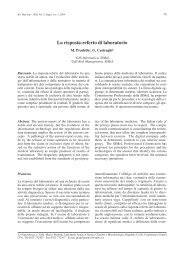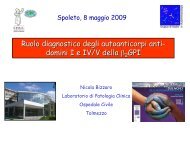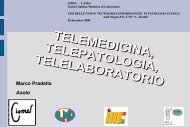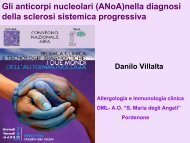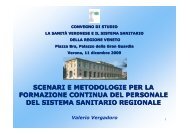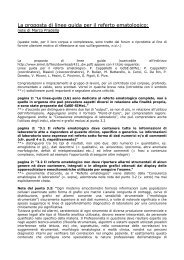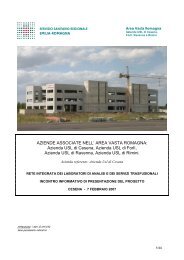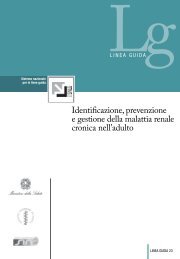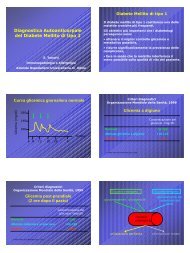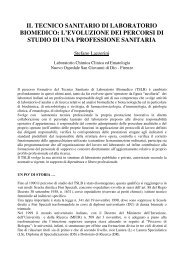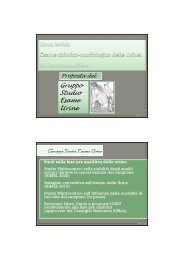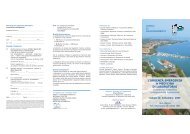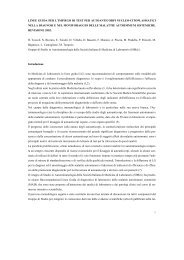Biomarcatori nell'inquadramento diagnostico delle malattie ... - Simel
Biomarcatori nell'inquadramento diagnostico delle malattie ... - Simel
Biomarcatori nell'inquadramento diagnostico delle malattie ... - Simel
You also want an ePaper? Increase the reach of your titles
YUMPU automatically turns print PDFs into web optimized ePapers that Google loves.
<strong>Biomarcatori</strong> nell’inquadramento<br />
<strong>diagnostico</strong> <strong>delle</strong> <strong>malattie</strong> infiammatorie<br />
croniche intestinali<br />
Dott. Ignazio Brusca<br />
U.O. di Patologia Clinica<br />
Ospedale Buccheri La Ferla<br />
F.B.F.<br />
Palermo<br />
Paestum 08 Giugno 2011
Morbo di Crohn<br />
Infiammazione segmentale, discontinua<br />
con predilezione del segmento distale<br />
dell’ileo.<br />
<br />
Esofago, stomaco e duodeno 3-5%<br />
<br />
Solo il piccolo intestino: 25-30%<br />
<br />
Piccolo intestino e colon: 40-55%<br />
<br />
Solo colon: 20-25% 25%<br />
<br />
Malattia anorettale: 20-40%<br />
<br />
Solo retto: 11-26%<br />
<br />
Incidenza: 1/1500<br />
Retto colite ulcerosa<br />
Infiammazione continua della mucosa del<br />
colon, che inizia quasi sempre dal retto<br />
Incidenza<br />
1/1-1.500<br />
1.500<br />
Tutto il colon: 18%<br />
Fino all’ansa sinistra superiore: 28%<br />
Rectosigmoide:<br />
54%
Mucosal and submucosal fibrosis,with abnormal<br />
collagen deposition,as wel las muscular hyperplasia.<br />
Fibrostenosing phenotype<br />
Chronic inflammatory reaction of<br />
the bowel wall, transmural, involves<br />
Immuno inflammatory cells as well as<br />
non immunecells,such as fibroblasts<br />
endothelial cells.The cytokines induce<br />
the production of proteases,<br />
Metalloproteinases, growth factors<br />
involved in tissue remodeling<br />
Inflammatory phenotype<br />
Perforating phenotype<br />
Penetrating lesions deep fissures give rise to covert<br />
perforation, paraintestinal abscess, free perforation or<br />
fistula.
-la malattia localizzata all’ileo è<br />
caratterizzata da un più alto tasso di<br />
intervento chirurgico, da una maggiore<br />
frequenza tra i familiari di primo e secondo<br />
grado e da una migliore risposta ai<br />
Corticosteroidi.<br />
-L’anti-TNF-a, l’anticorpo monoclonale<br />
adoperato per il trattamento della MC, è<br />
efficace nelle forme fistolizzanti<br />
ma è controindicato nelle stenosi
Predittivo sul successivo sviluppo della<br />
patologia<br />
Marcatore <strong>diagnostico</strong> sensibile e specifico<br />
In grado di differenziare tra loro le MICI<br />
Abile a valutare obiettivamente l' attività della<br />
malattia<br />
Abile a identificare il fenotipo<br />
In grado di monitorare gli effetti <strong>delle</strong> terapia<br />
Predittivo sui periodi di riacutizzazione
MARKERS DELLE MICI<br />
Marcatori di flogosi sierici:<br />
VES<br />
PCR<br />
Marcatori di flogosi fecali:<br />
Calprotectina<br />
Lattoferrina<br />
Marcatori anticorpali:<br />
Marcatori anticorpali:<br />
ASCA<br />
Omp C antibody<br />
I 2 antibody<br />
Anti-glicani (ACCA, ALCA,AMCA, AΣMA)<br />
Marcatori autoanticorpali:<br />
Anti-UBE4A IgG<br />
Anti globet cells<br />
Anti cellule esocrine del pancreas<br />
Anti GP2<br />
P-ANCA
Valore predittivo dei markers per MICI<br />
ASCA was present in 10 of 32 CD patients before they developed<br />
symptoms, compared to 0/95 controls and 0/8 UC<br />
The mean interval between ASCA detection and diagnosis was 38 months<br />
The role of p-ANCA in predicting the development of UC was unable<br />
to be determined due to small numbers.<br />
Israeli E et al. Gut. 2005; 54(9):1232–6
Marcatori sierici di flogosi nella<br />
prima diagnosi<br />
• PCR elevata in paziente con sintomi cronici<br />
del tubo gastroenterico impone indagini di<br />
esclusione per MICI<br />
Poullis AP et al Eur J Gastroenterol Hepatol.2002Apr;14(4):409–12. 12.<br />
• La PCR si eleva particolarmente nel Crohn<br />
meno nella CU<br />
Vermeire S et al Inflamm Bowel Dis. 2004 Sep;10(5):661-5<br />
Henriksen M et al Gut. 2008 Nov;57(11):1518-23<br />
• La VES è un markers meno sensibile ed<br />
affidabile nelle MICI<br />
Bitton A Gastroenterology. 2001 Jan;120(1):13-20. 20.
10 000<br />
Calprotectina fecale nella malattia di Crohn e<br />
nella sindrome da intestino irritabile (IBS)<br />
1000<br />
Faecal<br />
calprotectin<br />
mg/L<br />
100<br />
10<br />
1<br />
0.1 Crohn´s disease<br />
N = 31<br />
IBS<br />
N = 159<br />
Miscellaneous<br />
N = 30<br />
Gut 2000;47:506-513<br />
Tibble J Gut 2000;47:506-513
100<br />
VALORE DIAGNOSTICO DI UN VALORE DI<br />
CALPROTECTINA > 50<br />
75<br />
50<br />
25<br />
86<br />
59 63 96<br />
25<br />
88<br />
55 56<br />
7<br />
99<br />
Sensibilità<br />
Specificità<br />
Accuratezza<br />
VPP<br />
VPN<br />
0<br />
Diagnosi di "patologia organica"<br />
Diagnosi di neoplasia
Attività della Malattia:<br />
VES<br />
....One of the early studies in IBD showed a good<br />
correlation between ESR and clinical activity.<br />
The correlation was however dependent on<br />
disease location, and ESR correlated less well<br />
with UC restricted to the rectum and with CD<br />
restricted to the upper small bowel.....<br />
Sachar DB et al J Clin Gastroenterol. 1986;8(6):647-50<br />
Sachar DB et al J Clin Gastroenterol. 1990;12(6):643-6
Attività della Malattia:<br />
PCR<br />
both CRP and ESR correlated well with disease<br />
activity but the correlation was better for CRP.<br />
With respect to CD and UC, the correlation of<br />
laboratory markers with disease activity has been<br />
shown to be much stronger for CD than for UC.<br />
Fagan EA et al. Eur J Clin Invest 1982;12:351–9.35<br />
Solem CA et al. Inflamm Bowel Dis 2005;11:707–12.
Correlation between faecal excretion of indium-111-labelled<br />
granulocytes and calprotectin, a granulocyte marker protein, in<br />
patients with inflammatory bowel disease<br />
Røseth AG, Schmidt PN, Fagerhol MK.<br />
Faecal excretion of indium-111-labelled neutrophilic granulocytes has been<br />
suggested as the gold standard of disease activity, but its complexity and high cost<br />
and the exposure of patients to ionizing irradiation have limited the use of this<br />
technique<br />
There was a strong correlation between the average daily excretion of calprotectin<br />
and that of the total 3-day excretion of 111In-labelled granulocytes (r = 0.87, P <<br />
0.0001). Furthermore, the concentration of calprotectin, assessed in a small stool<br />
sample on day 1, also correlated well with the excretion 111In-labelled granulocytes<br />
(r = 0.80, P < 0.0001).:<br />
The results suggest that faecal calprotectin reflects the granulocyte migration<br />
through the gut wall in patients with IBD and hence might serve as a simple,<br />
inexpensive alternative to the indium-111 technique.<br />
Scand J Gastroenterol. 1999 Jan;34(1):50-4.
Marcatori di flogosi nel predirre<br />
ricadute<br />
I pazienti con valori di PCR > 20 mg/L e<br />
VES > 15 mm presentano un OR di 8.3 per<br />
ricaduta. Consigny Y et al Gastroenterology 2001;20(suppl):A53.<br />
Un valore basale di Calprotectina di 150<br />
mg/kg o più è predittivo di ricadute nei<br />
successivi 14 mesi Costa F et al. Gut 2005;54:364–8.<br />
Valori elevati di calprotectina devono<br />
essere considerati predittivi anche con<br />
largo anticipo sulla comparsa di sintomi<br />
Tibble J et al. Gastroenterology 2000;119:15–22<br />
D’Inca R et al. Gastroenterology 2005;128(suppl):A307.
Calprotectina vs markers<br />
infiammazione<br />
CD (n=43)<br />
relapse non relapse<br />
UC (n=37)<br />
relapse non relapse<br />
Fecal calprotectin (mg/L) 122 42 123 29 p
Marcatori di flogosi nella<br />
valutazione della efficacia<br />
terapeutica<br />
Decremento della PCR indica un buona<br />
risposta alla terapia<br />
Nei pazienti trattati con anti-TNF<br />
si ottiene<br />
buona risposta nel 76% di quelli con valori<br />
basali di PCR > 5 mg/L; nel 46% in quelli<br />
con valori di PCR < 5 mg/L<br />
Louis E et al. Scand J Gastroenterol 2002;37:818–24.
Marcatori anticorpali ed autoanticorpali nelle MICI<br />
ASCA<br />
I Saccharomyces<br />
cerevisiae sono agenti<br />
lievitanti, utilizzati<br />
nell’industria alimentare<br />
non patogeni per<br />
l’uomo.<br />
p-ANCA atipico
ASCA + ANCA nelle MICI
Rewiews in gastroenterology disorders 2004 Sandborn J et al
Anti Intestinal Goblet Cells<br />
Substrato: tessuti intestinali o linee cellulari derivate da<br />
neoplasia differenziate del colon (HT29-18-N2)
Anti Intestinal Goblet Cells<br />
Metodo UC CD Controlli s. Disease C. Bibliograf.<br />
IIF 14-46% 46% rari<br />
rari<br />
rari<br />
Broberger O et<br />
al.<br />
J.Gastroenterol<br />
2000 35:20-7<br />
IIF 11/57 0/222 0/65 0/100<br />
HT29-18-N2<br />
ELISA/WB<br />
Mucina purificata<br />
da pazienti con UC<br />
ELISA<br />
HT29-18-N2<br />
(19 %)<br />
11/60<br />
(18/%)<br />
18/48<br />
(38%)<br />
0/22 0/32 0/20<br />
5/15<br />
(33%)<br />
0/35 0/50<br />
Köhler S et al.<br />
World Patent<br />
Applications<br />
2005;<br />
Takaishi H et al<br />
J Gastroenterol.<br />
2000;35(1):71-<br />
2<br />
Hibi T et al.<br />
Gut.<br />
1994;35(2):224<br />
-30
Anti Pancreas Esocrino
20 % Crohn, 9.3 % RCU, 4 % Controlli<br />
Op De Beéck K, Vermeire S, Rutgeerts P, Bossuyt X.Gut. 2010 Dec 29
Autoantibodies to GP2, the major zymogen granule membrane<br />
glycoprotein, are new markers in Crohn's disease.<br />
Roggenbuck D, Reinhold D, Wex T, Goihl A, von Arnim U, Malfertheiner P, Büttner T,<br />
Porstmann T, Porstmann S, Liedvogel B, Bogdanos DP, Laass MW, Conrad K.<br />
….Anti-GP2 IgG and IgA were found in 48/72 (66.7%)<br />
and 23/72 (31.9%) PAB positive and 5/106 (4.7%)<br />
and 1/106 (0.9%) PAB negative CD patients<br />
(p
• 65 Crohn<br />
• 4 C.I.<br />
• 15 R.C.U.<br />
• 20 F.H.<br />
• 41 C.D.
Cut Off produttore= 20 UA<br />
IgG<br />
Sensibilità 30.8 % (21,7-39,8)<br />
Specificità 98.7 % (96,6-100,9)<br />
IgA<br />
Sensibilità 13.9 % (7.9-21.8<br />
Specificità 94.1 % (89.5-98.6)<br />
Cut Off ROC curve = 13 UA<br />
IgG<br />
Sensibilità 40 % (28.0-52.9)<br />
Specificità 96.3 % (89.5-99.2)<br />
IgA<br />
Sensibilità 21.5% (12.3-33.5)<br />
Specificità 88.9 % (79.0-94.8)
Anticorpi rivolti verso<br />
antigeni batterici<br />
Anticorpi anti-OmpC:<br />
anticorpi che<br />
riconoscono la proteina C presente sulla<br />
porzione esterna della membrana cellulare<br />
di Escherichia coli<br />
Anticorpi anti-I 2 : anticorpi che riconoscono<br />
una proteina di membrana di<br />
Pseudomonas fluorescens<br />
Anticorpi anti-CBir1:<br />
anticorpi anti-<br />
flagellina espressa da Clostridium phylum
Anti-OmpC, in the absence of ASCA and ANCA, is a serological pattern noted in a subset of medically<br />
complex cases in children and young adults without CD or UC.<br />
Davis MK et al J Pediatr Gastroenterol Nutr. 2007 Oct;45(4):409-13.
303 patients
Patients expressing I2 were more likely to have fibrostenosing Crohn's disease<br />
Patients with anti-Escherichia coli outer membrane porin C were more likely to have<br />
internal perforating disease<br />
Patients positive for I2, anti-Escherichia coli outer membrane porin C, and anti-<br />
Saccharomyces cerevisiae were the most likely to have undergone small bowel surgery<br />
(72.0%; odds ratio, 8.6; P < 0.001)<br />
90% of patients with small bowel disease who required surgery had high levels of I2,<br />
Escherichia coli outer membrane porin C, and oligomannan antibodies, compared with<br />
only 18.2% with low-titer responses (P < 0.001)
Anticorpi rivolti verso antigeni<br />
batterici<br />
• Recentemente sono stati identificati anticorpi (nei soggetti con morbo di<br />
Crohn) che riconoscono residui zuccherinici (glicani). Queste molecole<br />
sono espresse sui globuli rossi, sulle cellule del sistema immunitario ma<br />
anche sulla parete cellulare di batteri patogeni e miceti<br />
•Anti-laminaribioside (ALCA)<br />
•Anti-chitobioside (ACCA)<br />
•Anti-mannobioside (AMCA)<br />
•Anti-mannoside sintetico (AΣMA)<br />
•Anti chitina<br />
•Anti laminina<br />
• La presenza di questi anticorpi confermerebbe l’ipotesi che nei malati di<br />
Crohn vi è una perdita di tolleranza nei confronti di agenti microbici<br />
presenti nel lume intestinale a causa di un difetto del sistema immunitario
194 patients with CD, 162 with<br />
UC and 142 healthy controls,<br />
….44% (12/27) of anti-Saccharomyces cerevisiae antibody-negative<br />
Crohn's disease patients were positive for antilaminaribioside or<br />
antichitobioside…..
(gASCA), laminaribioside (ALCA), chitobioside (ACCA),<br />
mannobioside (AMCA), outer membrane porins (Omp)<br />
and the atypical perinuclear antineutrophilic cytoplasmic<br />
antibody (pANCA) were tested in serum samples of 1225<br />
IBD patients, 200 healthy controls and 113 patients with<br />
non-IBD gastrointestinal inflammation.
•76% dei pazienti con Crohn avevano almeno un<br />
marcatore anticorpale positivo<br />
• Per la diagnosi differenziale tra Crohn e CU la<br />
combinazione ASCA e pANCA è la più accurata.<br />
•Per la diagnosi differenziale tra MICI, sani e<br />
patologie infiammatorie enteriche non MICI la<br />
combinazione migliore è ASCA, pANCA and ALCA<br />
• La presenza di più marcatori e una concentrazione<br />
elevata di ASCA, ALCA, ACCA, AMCA and Omp è<br />
indicativa di una prognosi peggiore (trattamento più<br />
aggressivo)
Detection of antisynthetic mannoside antibodies (AΣMA) reveals<br />
heterogeneity in the ASCA response of Crohn's disease patients and<br />
contributes to differential diagnosis, stratification, and prediction.<br />
772 CD, 261 UC, 43 IC and 289 controls<br />
..the specificity of AΣMA for CD was quite similar to that of<br />
ASCA (89% vs 93%), the sensitivity was lower (38% vs<br />
55%)…<br />
…24% of the CD patients who were negative for ASCA<br />
and/or other CD-associated serologic markers were<br />
positive only for ΣMan4…<br />
…AΣMA was more sensitive (45% vs 27%) and more specific<br />
(100% vs 71%) than ASCA for predicting evolution of IC<br />
toward CD….<br />
Vandewalle-El Am J Gastroenterol 2008; 103: 949-957
Inflamm Bowel Dis. 2009 Mar;15(3):365-74<br />
...PAB was associated to perforating,<br />
...PAB was associated to perforating,<br />
perianal disease, arthritis, ocular, and<br />
cutaneous manifestations (P = 0.002-<br />
0.032)...
Autoantibodies against<br />
ubiquitination factor E4A (UBE4A) are associated with<br />
severity of Crohn's disease<br />
…UBE4A expression was highly elevated only in enteroendocrine<br />
cells of ileal, mucosa from CD patients, but not in normal subjects….<br />
The prevalence of anti-UBE4A IgG was significantly higher in CD<br />
than that in UC or healthy controls (46.2% vs 7.1% vs 3.3%,<br />
respectively; P < 0.0006). The levels of anti-UBE4A IgG were<br />
correlated well with the disease activity (P < 0.0001).More<br />
interestingly, higher level of anti-UBE4A IgG was associated with<br />
complicated disease behavior (P = 0.0028), and patients positive<br />
with anti-UBE4A IgG were more likely to undergo surgery (P =<br />
0.0013)<br />
Sakiyama T et al Inflamm Bowel Dis 2008; 14: 310-317<br />
Xuhang Li et al World J Gastroenterol 2008; 14(33): 5115-5124
PAB anti GP2<br />
ALCA<br />
ACCA<br />
AMCA<br />
AΣMA<br />
Anti chitina<br />
Anti laminina<br />
Anti UBE4A<br />
ASCA pANCA<br />
PCR VES Calprotectina fecale



